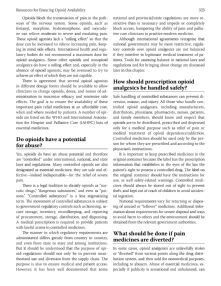Page 335 Guide to Pain Management in Low-Resource Settings
P. 335
Resources for Ensuring Opioid Availability 323
Opioids block the transmission of pain in the path- national and provincial/state regulations are more re-
ways of the nervous system. Some opioids, such as strictive than is necessary and impede or completely
fentanyl, morphine, hydromorphone, and oxycodo- block access, hampering the ability of pain and pallia-
ne can relieve moderate to severe and escalating pain. tive care clinicians to practice modern medicine.
Th ese opioid agonists lack a “ceiling eff ect” so that the Although international agreements recognize that
dose can be increased to relieve increasing pain, keep- national governments may be more restrictive, regula-
ing in mind side eff ects. International health and regu- tory controls over opioid analgesics are not balanced
latory bodies do not recommend a maximum dose for if they interfere in legitimate medical treatment of pa-
opioid analgesics. Some other opioids and nonopioid tients. Tools for assessing balance in national laws and
analgesics do have a ceiling eff ect and, especially in the regulations and for bringing about change are discussed
absence of opioid agonists, may be overused to try to later in this chapter.
achieve an eff ect of which they are not capable.
Th ere is agreement that several opioid agonists How should prescription opioid
in diff erent dosage forms should be available to allow analgesics be handled safely?
clinicians to change opioids, doses, and routes of ad-
ministration to maximize effi cacy and minimize side Safe handling of controlled substances can prevent di-
eff ects. Th e goal is to ensure the availability of these version, misuse, and injury. All those who handle con-
important pain relief medicines at an aff ordable cost, trolled opioid analgesics, including manufacturers,
when and where needed by patients. A number of opi- distributors, physicians, pharmacists, nurses, patients,
oids are listed on the WHO and International Associa- and family members, should know and respect that
tion for Hospice and Palliative Care (IAHPC) lists of opioids are to be distributed, prescribed and dispensed
essential medicines. only for a medical purpose such as relief of pain or
medical treatment of opioid dependence/addiction.
Do opioids have a potential Controlled medicines should be used only by the per-
for abuse? son for whom they are prescribed and according to the
physician’s instructions.
Yes, opioids do have an abuse potential and therefore It is important to keep prescribed medicines in the
are “controlled” under international, national, and state original container because the label has the prescription
laws and regulations. Many controlled opioids are also information that establishes in the eyes of the law the
designated as essential medicines; they are safe and ef- patient’s right to possess a controlled drug. Th e label on
fective—indeed indispensable—for the relief of severe the original container should have the instructions for
pain. use, as well safety-related warnings. Controlled medi-
Th ere is a legal tradition to classify opioids as “nar- cines should always be stored out of sight to prevent
cotic drugs,” “dangerous substances,” and even as “poi- theft, and kept out of reach of children to avoid acciden-
sons.” “Controlled substances” is a less stigmatizing tal ingestion.
term. Th e movement of controlled substances is subject National requirements vary for returning or dispos-
to government regulatory controls such as licensing, se- ing of unused or “leftover” medicines. Additional infor-
cure storage, inventory, recordkeeping, and reporting mation about requirements for secure disposal and ways
of procurement, storage, distribution, and dispensing. to avoid harm to others and the environment should be
A medical prescription is required to provide patients obtained from the relevant government authorities.
with lawful access to controlled medicines.
Th e manner in which regulatory requirements are What should be done if pain
administered diff ers greatly from country to country, medicines are diverted?
and even from state to state and among institutions.
But it should be understood that the purpose of opi- In some cases, opioid analgesics are unlawfully stolen
oid regulations should not only be to prevent unau- or “diverted” from various points along the drug distri-
thorized use and diversion from the supply chain. Th e bution system, and then sold for nonmedical purposes,
purpose is also to ensure medical and patient access. including to abusers. Abuse of essential medicines, es-
However, it has been well documented that some pecially if publicity is sensational and unbalanced, can


